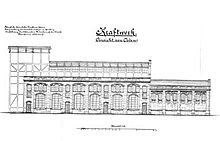Leverkusenstrasse power plant
| Leverkusenstrasse power plant | |||
|---|---|---|---|
| Boiler house and machine hall | |||
| location | |||
|
|
|||
| Coordinates | 53 ° 33 '55 " N , 9 ° 55' 58" E | ||
| country |
|
||
| Data | |||
| Type | Steam power plant | ||
| Primary energy | Fossil energy | ||
| Firing | Hard coal | ||
| Website | http://www.kraftwerkaltona.de/ | ||
The Leverkusenstrasse power plant in Hamburg-Bahrenfeld was used to supply power to the Hamburg-Altona city and suburban railway , which opened in 1907, and the Altona harbor railway. The railways were operated with overhead lines with a voltage of 6.3 kV and a frequency of 25 Hz. The Leverkusenstrasse power plant is Germany's first rail power plant . Today it is an office and commercial building.
history
In 1905/1906 the "Königliche Eisenbahn Direktion Altona" redesigned the rail traffic between the neighboring cities of Altona and Hamburg. Electric operation was introduced for the Blankenese - Ohlsdorf route. For this purpose, a steam power plant was built in Altona-Bahrenfeld directly on the track system, which was heated with hard coal . In contrast to all other Hamburg power plants owned by HEW and Hamburger Hochbahn AG , the power plant had no connection to a waterway, so the coal had to be delivered by train.
At the rear of the property was a 40 m high cooling tower, from which a cooling water channel ran in a ring under the entire building and back to the cooling tower. The water was used to cool the water in the steam circuit of the turbines. On the tracks, the first track was only available for the delivery of coal and the removal of the ash and slag . For this purpose, a transport system and a coal bunker were built directly on the railway embankment, so that the coal could be transported from the track by means of conveyor belts directly to the coal bunker or the power plant. A basin was available for the cooling water, which can still be seen under the S-Bahn viaduct of the connecting curve between Holstenstrasse and Diebsteich (as of 2017).
In 1909 the Altona Royal Railway Directorate expanded the power plant. The property was used by the legal successor “Deutsche Bundesbahn” until the 1960s, until it was bought in 1985 by Kurt Lingenbrink, owner of the Libri company; In 1994, Karin Lingenbrink began to convert the buildings.
Conversion
The main architectural intention of the renovation was to expose the original structure from the years 1906–1921 with its characteristic brick ornamentation. The switchgear building, machine hall and extension of the workshop building remained essentially unchanged in terms of the number of floors and the accessibility. Only the west and south facades were reconstructed after the extensions were torn down. The boiler house was completely gutted and rebuilt inside. With the extension, the total area today is 3,400 m 2 .
The tenants today include the editorial offices of several men's and computer magazines, an eCommerce fulfillment service provider, a photo studio, a software company, a dance studio, a party location and a restaurant.
Individual evidence
- ↑ 53 ° 33 '52 ″ N , 9 ° 56 ′ 7.7 ″ E Position of the cooling water basin
- ^ Kraftwerk, Leverkusenstrasse - Hamburg - data . Site of the former power station. Retrieved April 10, 2014.
Web links
Altona power plant history - details about the former power plant






